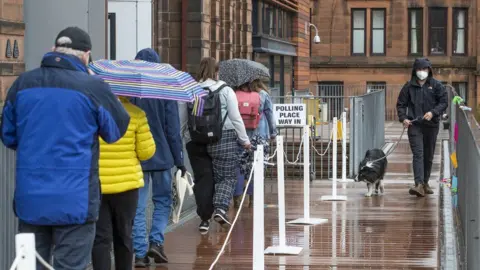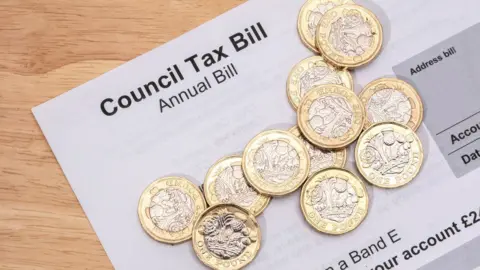Where do the parties stand ahead of the Scottish council elections?
 Getty Images
Getty ImagesThe local elections on Thursday will decide who runs Scotland's local councils for the next five years.
The newly elected councillors will be responsible for running a range of vital services, including bin collection, schools and social care.
However, many voters will not be voting on how well or badly they think their council is being run - but rather backing the party for which they would vote in a Holyrood or Westminster election.
The results will therefore give us a measure of the popularity of the parties a year on from last year's Holyrood ballot.
The electoral system, though, is different from last year. Thursday's ballot will be held using the Single Transferable Vote under which voters rank their local candidates in order of preference - one, two, three, etc.
This system is roughly proportional - though with only three or four councillors elected in each ward. To have much chance of winning a seat a party has to be able to win as much as 15% or so of the first preference vote.
Candidates with too few votes are eventually eliminated from the count and their votes transferred in accordance with their supporters' second and subsequent preferences.
 PA Media
PA MediaThe last local elections were in 2017 - shortly before the Westminster election of that year in which the SNP suffered a substantial reverse and the Conservatives won their highest share of the vote in Scotland since 1979.
These trends were reflected in the outcome of the local elections.
The Conservatives recorded their best local election performance since 1982. In winning 25% of the first preference vote the party almost doubled the tally it secured in 2012. Labour slumped into third place with just 20%.
The SNP recorded what seemed a rather disappointing performance, advancing not at all on the 32% they had recorded five years earlier - even though in the meantime the party had dramatically won 50% of the vote in the 2015 UK general election.
The Conservatives appear to be in a much weaker position now. On average the party has scored 20% in recent polls of Westminster vote intentions, well down on the 30% that it was recording shortly before the 2017 local elections.
Indeed, mirroring the party's decline in the Britain-wide polls since "partygate" first became news, the party has now fallen behind Labour, who are currently averaging 26%.
If the Conservatives do come behind Labour on Thursday, it will be the first time since 2016 that they have failed to command second place in a Scotland-wide ballot.
Labour would doubtless claim that the party has now turned the corner. However, its current standing in the polls is still no more than it achieved in the 2017 UK general election.
The SNP are running on average at 43% in the current polls. That is no better than its position shorty before the 2017 local elections, though it is well above the 37% the party secured in the 2017 general election.
 Getty Images
Getty ImagesThe polls appear to have been overestimating SNP support in advance of the 2017 general election, and the party will be hoping that this means its current popularity is in practice sufficient to produce an advance.
The elections will be the first to be fought by the Greens since the party agreed to take two positions in the SNP-led administration at Holyrood.
The polls suggest that this move has not done the party any harm at all, and at 11% its current standing in Holyrood list vote intentions is a couple of points up on five years ago.
However, some of the Greens' Holyrood vote consists of tactical support from SNP voters. So far, other than in Edinburgh and Glasgow, the party has struggled to win enough first preference support in local elections to win more than the occasional seat.
It is hoping to improve on that record this time around - while, if it fails to do so, the SNP will be hoping to profit from the second preferences of Green voters.
Local popularity
The Liberal Democrats seem unlikely to do much more than tread water once again. The party is currently running at 6% in the Westminster polls, a point down on 2017.
It is, however, relatively successful at picking up second preferences from Conservative and Labour supporters, which may help it secure the last seat in some wards.
Meanwhile, Alex Salmond's Alba party, which is contesting just under a third of the 355 wards, is hoping to register its first electoral success. However, the polls are not encouraging, giving the party just 2-3% of the vote.
Thursday's ballot will not, however, just be about party politics. Because under STV voters vote for individual candidates rather than, as in Holyrood's system, for a party list, Independent candidates have been able to win election, and especially so in rural Scotland.
Independent councillors dominate in Comhairle nan Eilean Siar, Orkney, and Shetland, while as much as 10% of the first preference vote across Scotland was won by Independent candidates.
Although fewer Independent candidates are standing this year, their presence makes it unlikely that any of the parties will fully match their current poll rating on Thursday.
That will serve as a reminder that sometimes local popularity matters more than party politics.
Sir John Curtice is Professor of Politics, Strathclyde University, and Senior Research Fellow, ScotCen Social Research.
